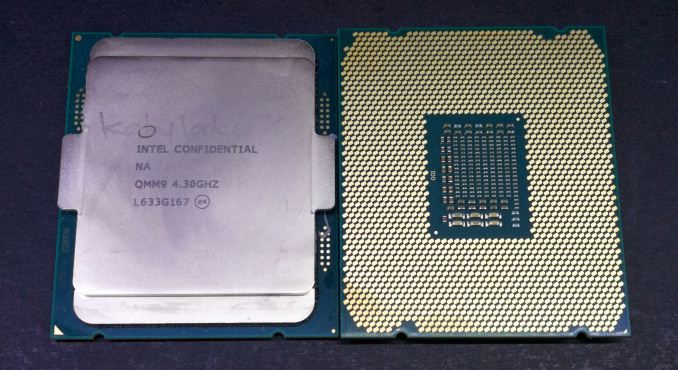Intel Releases Advisory: Update X299 for Cascade-X, and Lose Kaby-X Support
by Dr. Ian Cutress on October 10, 2019 8:50 AM EST- Posted in
- CPUs
- Intel
- X299
- Kaby Lake-X
- i7-7740X
- i5-7640X
- Cascade Lake-X

Motherboard firmware is a fickle thing: in order to support as many CPUs as possible, especially in the multi-core and turbo era, each processor has to have its own entry in the support table in the BIOS. With luck, some processor variants can share entries, but ultimately the more processors a platform supports, the larger the BIOS firmware tends to be. As we have moved from basic BIOS implementations to complex UEFI interfaces, the amount of free space inside BIOS firmware has reduced drastically.
As a result, in recent generations, we’re seeing motherboards drop support for certain ranges of processors. Recently, a range of AMD AM4 motherboards have dropped support for the earliest A-series processors that were supported on the platform, mostly because these parts were not widely used at the end of the day. Now, Intel is doing the same thing: for users who invested in the X299 platform, in order to support the new Cascade Lake-X processors, that same BIOS version is unlikely so support the quad-core Kaby Lake-X processors.
Intel killed off the low-core count Kaby-X parts quite a while ago – they were only launched on the platform to afford the latest microarchitecture on the HEDT platform for users who wanted large memory sizes and the best single-core performance available. Due to the high price of X299 motherboards at the time, and the lack of additional PCIe lanes, the products received a poor reception, and the idea of this ‘latest microarchitecture on low-core count HEDT’ idea was quickly swept under the rug. Retailers got rid of Kaby Lake-X stock as well.
Some motherboard vendors may still support Kaby Lake-X, depending on the size of the BIOS chip used in their products. Typically a 2x increase in BIOS chip capacity affords a 3-4x BOM cost at the high-end, so you can imagine that motherboard vendors want to keep it efficient. Nonetheless, due to the latest flashy UEFI interfaces, what used to be a bunch of free space is now jam packed, and something has to give when new generations of hardware are released on the same platform.
With this new Intel Advisory, it ultimately should not affect most Intel HEDT users. If you were unfortunate enough to be a Kaby-X user, then it might not be worth upgrading your system BIOS ever again, unless you plan to upgrade in the future. For everyone else, it is business as usual.
Related Reading
- Intel Announces EOL Plan for Kaby Lake-X Processors
- The Intel Kaby Lake-X i7 7740X and i5 7640X Review
- Intel Announces Kaby Lake-X Processors
Source: Intel











23 Comments
View All Comments
1_rick - Thursday, October 10, 2019 - link
My mistake--they removed Bristol Ridge support.But my point was that "removing features is pretty rare, but it does happen".
HideOut - Tuesday, October 15, 2019 - link
However, there is a chance that the newest 5xx chipsets will have to remove 1xxx ryzens for the same reason.imaheadcase - Thursday, October 10, 2019 - link
THe problem is when people do have a PC issue, its the standard "upgrade all drivers/bios/etc" to see if fixes issue.shabby - Thursday, October 10, 2019 - link
These aren't $99 boards, can't they spend a bit more for a larger bios chip?chaos215bar2 - Thursday, October 10, 2019 - link
This.I would have assumed that with more complex BIOS/UEFI implementations would come larger storage for the resulting images. Is there a reason that isn't possible? Even "large" here is downright microscopic compared to most modern storage media.
GreenReaper - Thursday, October 10, 2019 - link
Sure, they can, but realistically: did you ask about BIOS flash capacity before your last motherboard purchase? No? And now you know, is it going to be a big factor in your next purchase? Not really? Well, nor does just about anyone else, so it doesn't factor into feature selection unless the manufacturer knows it'll increase greatly support costs - which it probably won't.1_rick - Thursday, October 10, 2019 - link
To be fair, they did already EOL Kaby Lake-X quite some time ago, and nearly nobody bought those chips anyway.peevee - Thursday, October 10, 2019 - link
"the amount of free space inside BIOS firmware has reduced drastically."Flash being as cheap as it is, a modern chipset should have something like 128GB-256GB of flash built-in (in no-latency PoP configuration), share it between BIOS code and boot partition as necessary and be done with it.
EliteRetard - Thursday, October 10, 2019 - link
MOBO makers are just now (reluctantly) being forced to use 32MB chips vs the old 16MB ones (yes, megabyte). Convincing them to even go 128MB (NOT GB) would be astonishing.rpg1966 - Thursday, October 10, 2019 - link
If mobo makers won't provide more storage for BIOS, why not just provide two versions of each BIOS, between them containing the data required the full range of processors?